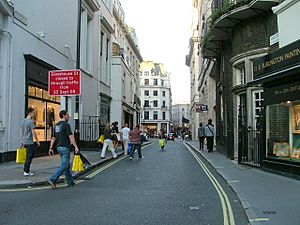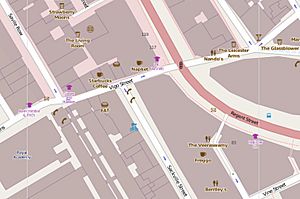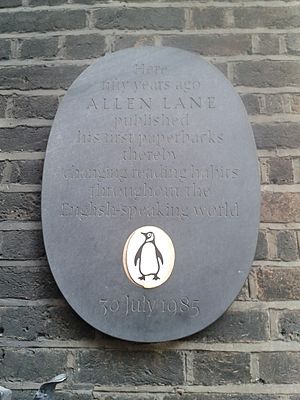Vigo Street facts for kids
Vigo Street is a short but famous street in central London. It was first called Vigo Lane. The street got its name from a big naval victory. This was the 1702 Battle of Vigo Bay, where British and Dutch ships won against French and Spanish ships. Vigo Street is also well-known for its important connections to books and writers.
Where is Vigo Street?
Vigo Street is located right in the heart of London. It connects two other well-known streets: Regent Street and the area where Burlington Gardens meets Savile Row. Another street, Sackville Street, branches off from the middle of Vigo Street and goes south. The back entrance to a famous building called Albany is also found near the end of Vigo Street.
The Story of Vigo Street
At first, a much larger road was called Glasshouse Street. This road stretched from what is now Bond Street all the way to the current Glasshouse Street.
After the important naval victory at the Battle of Vigo Bay in 1702, a part of Glasshouse Street was renamed Vigo Lane. Later, it became known as Vigo Street. However, some maps and books, like Elmes's London Streets from 1831, still used the old name "Vigo Lane."
Eventually, the part of Vigo Street that was behind Burlington House got a new name. By 1831, this section was renamed Burlington Gardens.
Vigo Street and Books
Vigo Street has a rich history with publishers and famous authors. Two publishers, John Lane and Elkin Mathews, worked together on Vigo Street. They published the first two parts of a well-known magazine called The Yellow Book in 1894. Later, they started a publishing company called The Bodley Head. They continued to publish The Yellow Book until it stopped in 1897.
After Lane and Mathews stopped working together, both kept their offices on Vigo Street. Elkin Mathews published many important books. These included The Wind Among the Reeds by W.B. Yeats in 1899. He also published Chamber Music by James Joyce in 1907. Other famous writers like Lionel Johnson, John Masefield, J.M. Synge, and Ezra Pound also had their works published by Mathews.
A very famous moment in publishing history happened at 8 Vigo Street. In 1935, Allen Lane started Penguin Books there. It was part of the Bodley Head company at first. In 1985, Penguin put up a special plaque on number 8. This plaque celebrates 50 years since the first Penguin paperback books were created.
Vigo Street also appears in famous stories. In Arthur Conan Doyle's adventure book The Lost World (1912), a character named Lord John Roxton walks down Vigo Street. He goes into his rooms at Albany, which the author describes in great detail.
In Graham Greene's book The End of the Affair (1951), a private detective agency is located at 159 Vigo Street.
See also
 In Spanish: Vigo Street para niños
In Spanish: Vigo Street para niños




